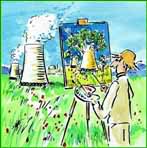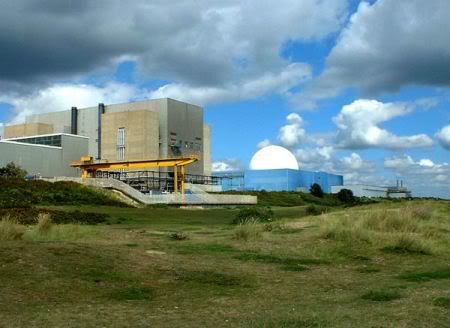
In light of concerns about climate change, the role of nuclear power in a future or transitional energy system has been re-evaluated. Worries about nuclear plant safety, nuclear weapons proliferation, and nuclear waste are being balanced against the fact that nuclear plants, during their operation, do not emit carbon dioxide into the atmosphere.
Unlike coal-fired generation, nuclear power technologies, especially if we consider prototype reactors, vary greatly and massive government investment has gone into researching a wide variety of reactor designs; however, one type, the pressurized light water reactor, still predominates in commercial nuclear plants. I will treat nuclear as two concepts then, existing nuclear and potential nuclear designs. I am considering potential future nuclear designs because the physics and history shows at least the potential for a high energy yield, though at a price worth assessing.
A. Existing nuclear (pressurized light water reactors)
Most existing nuclear reactors use regular (light) water as both a coolant and what’s called a neutron moderator. They depend on an enrichment process by which fuel pellets are formed with a higher concentration of the fissionable isotope Uranium 235 rather than the much more common and stable U238 isotope. These reactors’ pros and cons are as follows:
Pro:
- Carbon neutral under operation.
- Established technology with track record of producing electricity with few safety incidents.
- Produce power in the same profile as most coal generation plants (a constant baseload); can be used as a coal substitute.
- Remaining Uranium 235 supply functions as an energy store that can be tapped into at will.
- Nuclear power enables power production in areas with poor natural and renewable resources.
- Nuclear fuel is compact and highly energy dense.
Con:
- Produces large amounts of highly radioactive nuclear waste that will need to be stored for millennia in isolation from the biosphere.
- The uranium enrichment process can also produce higher concentrations of U235 suitable for nuclear weapons.
- The Chernobyl reactors were pressurized light water reactors; accidents and assaults on these plants have a chance of resulting in catastrophic releases of radioactive materials.
- Naturally occurring, economically extractable U235 will run out sometime in the latter half of the 21st century, especially if new nuclear plants are built out aggressively.
- Constructing nuclear power stations takes over five years, making them ineffective in a crucial period of climate change.
- Inclusive of insurance costs, which are so high that they must be assumed by governments and therefore taxpayers, nuclear power stations are very expensive.
Pressurized light water reactors then are not a particularly promising solution to our energy crisis, especially in the longer term.
B. A future fuel-reprocessing or thorium-based nuclear power system

Some nuclear power advocates believe that most or all of the drawbacks of the current nuclear power system can be remedied through technological development of a combination of new reactor designs, new ways to process fuel, and the extraction of fissionable fuels (uranium and thorium) from new sources. In sum or as piecemeal solutions, these changes are supposed to reduce the toxicity and amount of nuclear waste, increase the amount of fissionable fuel up to several thousand-fold, and reduce the risk of nuclear proliferation. These technologies, however, do not represent a unified plan but rather a series of technology proposals that build upon past or existing prototype reactor designs and fueling systems that have either been built or speculatively might be built.
One of the objectives of these scenarios is to widen the potential base of nuclear fuels by creating reactors that can turn much more plentiful Uranium 238 or Thorium 232 into a fissionable fuel (Uranium 233 or 235 or Plutonium 239). Others suggest extracting fuel from sea water, which has a small but nevertheless plentiful fraction of uranium isotopes in it. The net effect of these new fuel processing and sourcing proposals is to extend the supply of fissionable fuels to hundreds if not thousands of years into the future. Still others suggest reactor designs that will not allow weapons-grade uranium and plutonium to be isolated. Some tactics involve using discarded nuclear wastes as fuels as well as producing a much smaller radioactive waste product with a half-life in the hundreds of years rather than in the tens of thousands of years.
Out of concern for the urgency of the climate crisis, I depart from the orthodoxy of some advocates of renewable energy by agreeing that it is desirable to do research into reactor designs that at least reduce the toxicity of current nuclear waste and create a safer nuclear fuel cycle. While it is difficult to pin down what the pros and cons of this ideal future nuclear energy system might be, the following are some advantages and disadvantages of foreseeable nuclear power systems:
Opportunities:
- Carbon neutral or negative (in certain conditions) under operation.
- A future nuclear system might be able to reduce our current nuclear waste problem.
- Fuel is compact and easily transportable.
- Nuclear energy that can make U238 or thorium fissionable can tap into a very large store of fuel, and can therefore be used at will for many years to come; according to advocates, for thousands of years.
- Like conventional nuclear power, could produce baseload power, substituting for coal generation.
- Removing proliferation risks could make cleaner power available to more countries.
- Safer reactors are desirable if nuclear energy is to continue to be part of our energy mix.
- Nuclear power enables power production in areas with poor natural and renewable resources.
Risks and disadvantages:
- The described future nuclear system is more than a decade and perhaps decades away. Climate change is upon us now.
- All nuclear power irreversibly transforms its fuel into less energetic fuels; even after thousands of years, it will run out.
- The promised benefits may not materialize.
- The complexity of these proposed systems is very high, making oversight difficult and increasing the potential for unforeseen difficulties and consequences.
- As yet uncharted safety issues will emerge with new radioactive fuels.
- Developing these systems would be a major expense drawing on government research funds diverted from less elaborate technological systems like renewable energy and energy storage.
- Existing fuel reprocessing systems have proliferation risks attached; they isolate plutonium.
- The compact power of fissionable elements may have more appropriate uses in some future technology (spaceships?) other than power generation for daily use.
The nuclear electron economy, be it in its conventional form or a potentially improved future form, is a runner-up to the renewable electron economy largely because it is not ultimately sustainable, carries with it large technological and safety risks, and its deployment as a substitute for fossil generation is many years away.
Up next: the first-place choice for primary energy.

